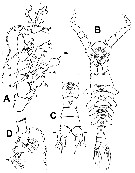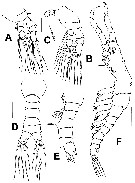|
|
 |
|
Monstrilloida ( Order ) |
|
|
|
Monstrillidae ( Family ) |
|
|
|
Australomonstrillopsis ( Genus ) |
|
|
| |
Australomonstrillopsis crassicaudata Surarez-Morales & McKinnon, 2014 (M) | |
| | | | | | | Ref.: | | | Suarez-Morales & McKinnon, 2014 (p.315, Descr.M, figs.M, Rem.) |  Issued from : E. Suarez-Morales & A.D. McKinnon in Zootaxa, 2014, 3779 (3). [p.316, Fig.9]. Male (from 19°7.34'S, 146°53.024'E): A, left A1 'dorsal view); B, habitus showing bulging perioral processes (arrows), ventral view; C, urosome and caudal rami showing suture-like constrictions (arrows), ventral view; D, cephalic area (lateral view) showing oral papilla (arrow) and adjacent protuberances. Scale bars: A, C, D = 50 µm; B = 100 µm. Nota: Cephalothorax representing 47 % of total body length (measured from the anterior end of cephalothorax to the posterior end of the anal somite). A1 reoresenting 81 % of cephalothorax length. Oral papilla small, located anteriorly, about 25 % of way back along ventral surface of cephalothorax (arrowed in fig.9B). Pair of ocelli present, pigment cups moderately developed, separated by half eye diameter, weakly pigmented; ventral cup about as large as lateral cups. Forehead rounded. Ventral surface of perioral area with 3 sac-like protrusions, 1 between usual nipple-like processes and surrounded by field of transverse cuticular striae, additional pair of larger processes flanking oral papilla (arrowed in figs.9B and 10F). Cephalothorax with irregular pattern of coarse cuticular folds and protuberances visible in lateral and ventral views (figs.9B and 10F). A15-segmented, geniculate; element 1 present on 1st segment, biserially setulate; element 2d1, 2d2, 2v1 2v2, 2v3, and IId present on 2nd segment; 3rd segment with elements 3, IIId, and IIIv; element 3 remarkably long, reaching to midlength of 4th segment; segment 4 bearing elements 4de, 4v1-3 as well as IVv and IVd. Terminal segment with reduced armature, only elements 1, 2 and 5 and unbranched elements A-D being present on both antennules; terminal antennular segment with low inner rounded expansion and secondary rounded protuberance on proximal half, and distal half modified as short, distally curved, sabre-like structure (fig.9A) Urosome consisting of 5 somites: 5th pedigerous somite, genital somite with genital apparatus, 2 free postgenital somites and anal somite (longer than 2nd free post genital somite). Ventral surface of genital somite forming protuberant base of very short shaft with distal genital lappets. Lappets represented by pair of rounded, poorly developed, posteriorly directed processes separated by shallow medial notch (fig.9C).
|
 Issued from : E. Suarez-Morales & A.D. McKinnon in Zootaxa, 2014, 3779 (3). [p.317, Fig.10]. Male: A, P1; B, P4; C, outer basipodal seta of P3; D, urosome and modified caudal rami (dorsal); E, same with caudal setae cut short (lateral); F, habitus (lateral; swimming setae omitted). A-E = 50 µm; F = 100 µm. Nota: 1st pedigerous somite incorporated into cephalothorax (fig.9B and 10F). P5 absent. Postgenital somite bearing ventral rounded process (arrowed in fig.10E). Caudal rami each with 5 setae, but rami of remarkably unusual form: massively developed, almost as long as anal and preanal somites combined, with transverse suture resembling intersegmental division (fig.10D); each ramus with several secondary process, each process armed with 1 terminal seta; other processes including medial one armed with 1 seta and outer one with 2 setae.
|
 Issued from : E. Suarez-Morales & A.D. McKinnon in Zootaxa, 2014, 3779 (3). [p.318]. Male: Armature formula of swimming legs P1 to P4. Spines: Roman numerals; setae: Arabic numerals. The element or elements on the outer margin of any segment are given first, separated by a hyphen from the inner margin element or elements. The armature on the terminal segment of each ramus has three components separated by commas and are given in the sequence: outer margin, distal margin, inner margin. (Huys & Boxshall, 1991, p.28)
| | | | | NZ: | 1 | | |
|
Distribution map of Australomonstrillopsis crassicaudata by geographical zones
|
| | | | Loc: | | | E Australia (Davies Reef, Queensland)
Type locality: 19°7.34'S, 146°53.024'E. | | | | N: | 1 | | | | Lg.: | | | (1149)* M: 0,54; {M: 0,54}
* Body length measured from the anterior end of cephalothorax to the posterior end of the anal somite. | | | | Rem.: | For Suarez-Morames & McKinnon (2014, p.318) tje male specimen is similar to those of the genus Monstrillopsis in the possession of a modified 5th antennular segment with inner rounded protiberances and an attenuated distal half resembling a short,curved, sabre. Also, the oral papilla is far anterior on the cephalothorax (Suarez-Morales & al., 2006).
This species has a combination of characters not found in any other known monstrilloid, such as the reduced genital complex, the sac-like protuberances in the perioral area of the cephalothorax, the absence of an inner seta on the 1st exopodal segment of P1-P4, the presenxe of a process on the ventral surface of the postgenital somite, and the remarkable, highly modified structure of the caudal rami, with a development and size which are unique among all known monstrilloids. The female of this species is unknown but it is expected that it could be easily recognizable by the presence of these unique characters. | | | Last update : 17/08/2021 | |
|
|
 Any use of this site for a publication will be mentioned with the following reference : Any use of this site for a publication will be mentioned with the following reference :
Razouls C., Desreumaux N., Kouwenberg J. and de Bovée F., 2005-2025. - Biodiversity of Marine Planktonic Copepods (morphology, geographical distribution and biological data). Sorbonne University, CNRS. Available at http://copepodes.obs-banyuls.fr/en [Accessed October 20, 2025] © copyright 2005-2025 Sorbonne University, CNRS
|
|
 |
 |





